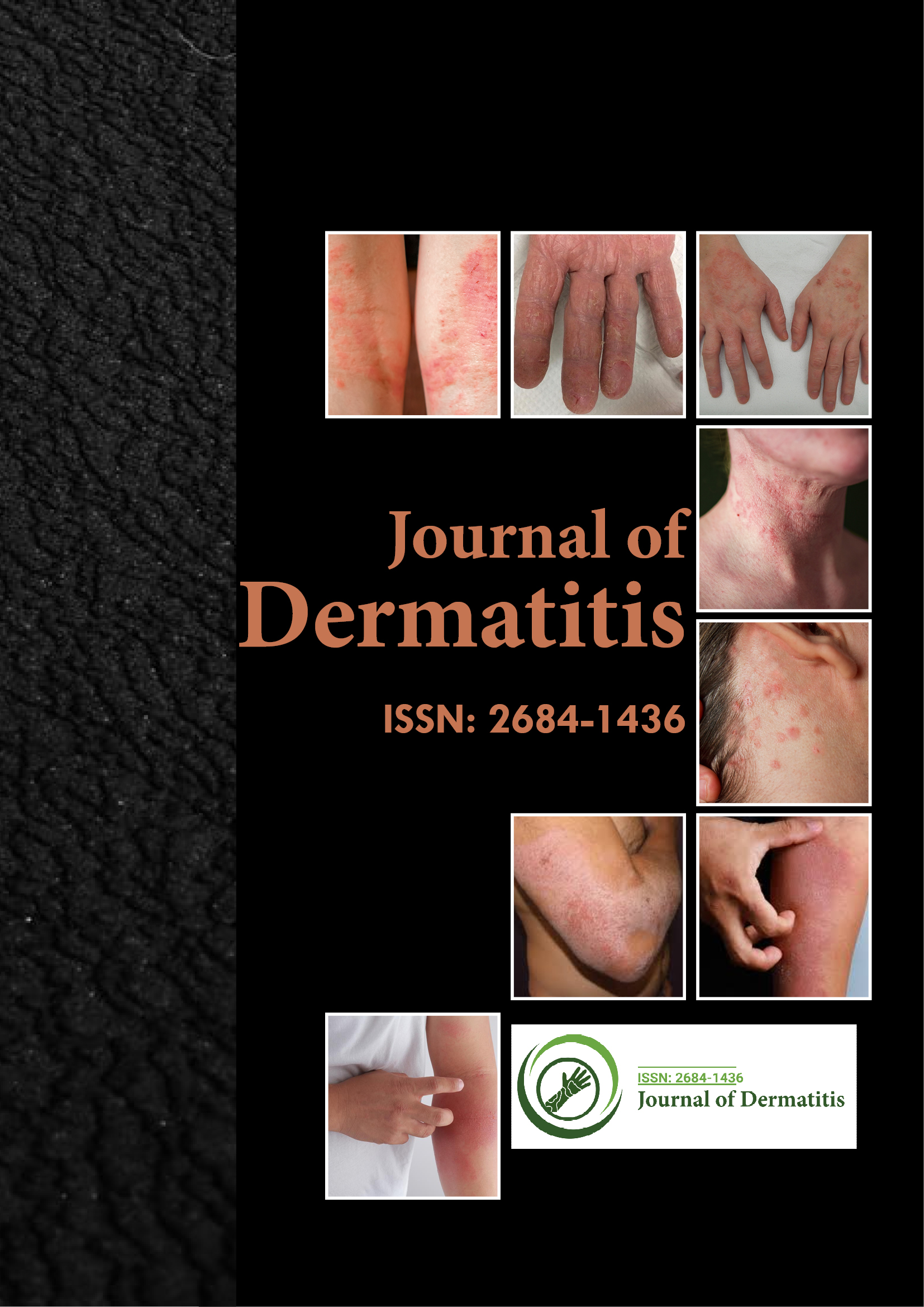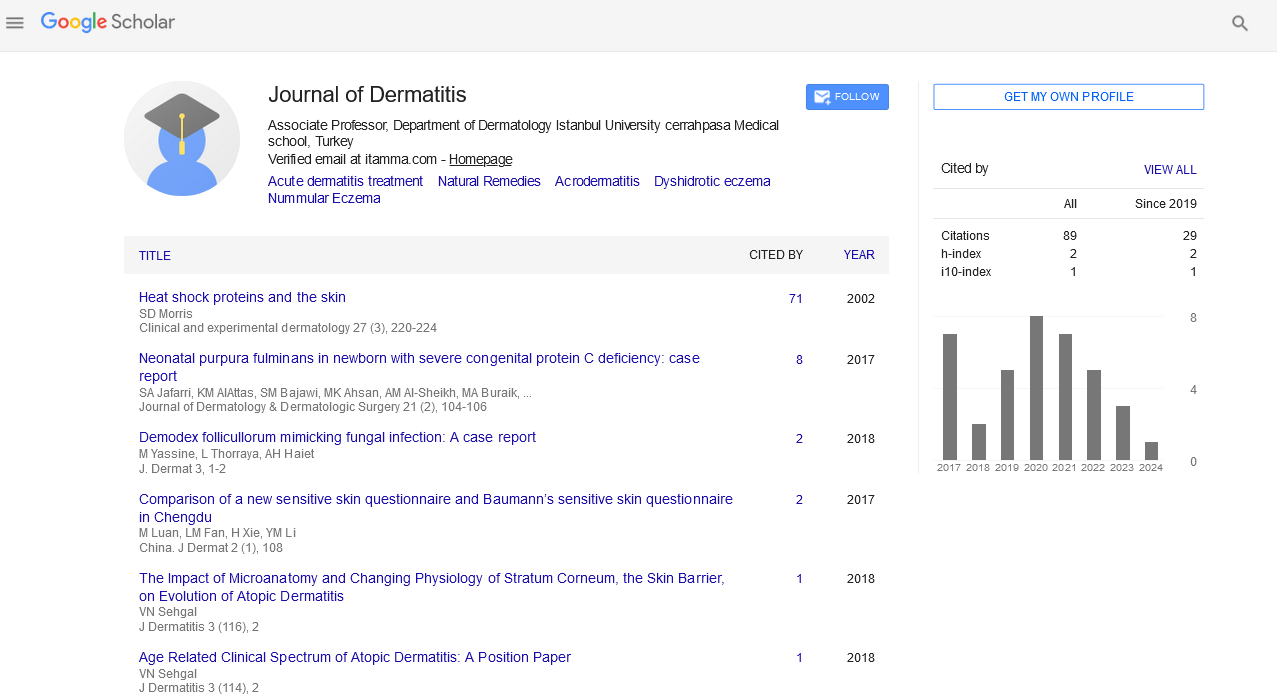Indexed In
- RefSeek
- Hamdard University
- EBSCO A-Z
- Euro Pub
- Google Scholar
Useful Links
Share This Page
Journal Flyer

Open Access Journals
- Agri and Aquaculture
- Biochemistry
- Bioinformatics & Systems Biology
- Business & Management
- Chemistry
- Clinical Sciences
- Engineering
- Food & Nutrition
- General Science
- Genetics & Molecular Biology
- Immunology & Microbiology
- Medical Sciences
- Neuroscience & Psychology
- Nursing & Health Care
- Pharmaceutical Sciences
Perspective - (2025) Volume 10, Issue 1
Immune and Barrier Modulation by Sunlight in Dyshidrotic Eczema Patients
Michael Reay*Received: 25-Feb-2025, Manuscript No. JOD-25-29123; Editor assigned: 27-Feb-2025, Pre QC No. JOD-25-29123 (PQ); Reviewed: 13-Mar-2025, QC No. JOD-25-29123; Revised: 20-Mar-2025, Manuscript No. JOD-25-29123 (R); Published: 27-Mar-2025, DOI: 10.35248/2684-1436.25.10.266
Description
Dyshidrotic eczema is characterized by small, deep-seated blisters on the palms and soles, often filled with clear fluid. These lesions typically present in symmetrical patterns, followed by desquamation and skin thickening during healing. The condition is episodic in nature and may persist for weeks or recur frequently. Although the exact etiology remains elusive, contributing factors include stress, allergens, hyperhidrosis, irritants, and seasonal variation.
Among various supportive measures, controlled exposure to sunlight has emerged as a potential complementary approach to manage inflammation and improve skin barrier integrity. This therapeutic concept draws upon established dermatological practices where Ultraviolet (UV) light exposure is used under medical supervision for inflammatory skin diseases such as psoriasis and atopic dermatitis.
Dyshidrotic eczema pathophysiology
The pathological process in dyshidrotic eczema involves inflammatory cell infiltration, intercellular edema in the epidermis and spongiosis. Although it was once believed to arise due to sweat gland dysfunction, this theory has largely been set aside. The vesicles are now thought to result from inflammatory responses rather than fluid retention in sweat glands.
Triggers such as nickel or cobalt sensitivity, fungal infections, or emotional stress can activate immune pathways involving T-cells and cytokines like interleukin (IL)-4, IL-13, and IL-17. Skin barrier disruption often follows these immune reactions, resulting in increased transepidermal water loss and vulnerability to external irritants. Managing inflammation and restoring barrier function are key goals in treatment, where adjunctive exposure to sunlight may offer some benefit.
Role of sunlight in dermatology
Natural sunlight encompasses a broad spectrum of electromagnetic radiation, including Ultraviolet A (UVA), Ultraviolet B (UVB), visible light and infrared rays. While overexposure to UV radiation is linked to skin aging and cancer, controlled and timed exposure has shown immunomodulatory effects beneficial in various skin disorders.
Phototherapy, a medical application of specific UV wavelengths, is widely used in conditions such as psoriasis, vitiligo and atopic dermatitis.
Sunlight exposure and dyshidrotic eczema
Though few large-scale studies have specifically focused on sunlight exposure in dyshidrotic eczema, anecdotal and clinical observations report seasonal improvement in some individuals. Many patients describe fewer outbreaks during summer months and worsening symptoms in colder, less sunny seasons.
In a small-scale observational survey, patients who spent regular time outdoors during morning hours (between 8–10 a.m.) reported fewer vesicular eruptions and faster resolution of existing lesions. This observation, while not definitive, supports further exploration into the incorporation of natural light exposure into disease management.
Potential mechanisms
Several mechanisms through which sunlight may exert its influence on dyshidrotic eczema include.
Immunomodulation: Controlled UV exposure can modulate Langerhans cells and T-cell activity in the epidermis, reducing the inflammatory response that drives vesicle formation and itching.
Skin barrier enhancement: Mild UVB exposure may induce hyperplasia and promote the synthesis of epidermal lipids, aiding in skin barrier restoration, which is often impaired in dyshidrotic eczema.
Reduction in microbial load: UV light possesses mild antimicrobial properties. By reducing colonization of skin microbes that may act as irritants or superantigens, sunlight may contribute to an environment less prone to flare-ups.
Stress reduction: Time spent in natural settings has psychological benefits that may indirectly influence disease course. Since stress is a known trigger for dyshidrotic eczema, outdoor exposure may help through behavioral pathways.
Vitamin D production: UVB radiation promotes endogenous synthesis of vitamin D3, which plays a role in immune regulation and may help modulate skin inflammation. Several studies have associated vitamin D deficiency with various inflammatory skin conditions.
Controlled sunlight exposure may serve as a supportive measure in the management of dyshidrotic eczema. By modulating immune function, enhancing barrier recovery and contributing to psychological well-being, sunlight may provide mild therapeutic benefits when used cautiously and appropriately. It should be considered as part of a comprehensive care plan, ideally under medical guidance, especially for patients with frequent recurrences or inadequate response to standard therapy. Although not a replacement for primary treatments, its potential in improving quality of life and reducing symptom severity makes it a valuable option worth further investigation.
Citation: Reay M (2025 Immune and Barrier Modulation by Sunlight in Dyshidrotic Eczema Patients. J Dermatitis. 10:266.
Copyright: © 2025 Reay M. This is an open-access article distributed under the terms of the Creative Commons Attribution License, which permits unrestricted use, distribution, and reproduction in any medium, provided the original author and source are credited.

